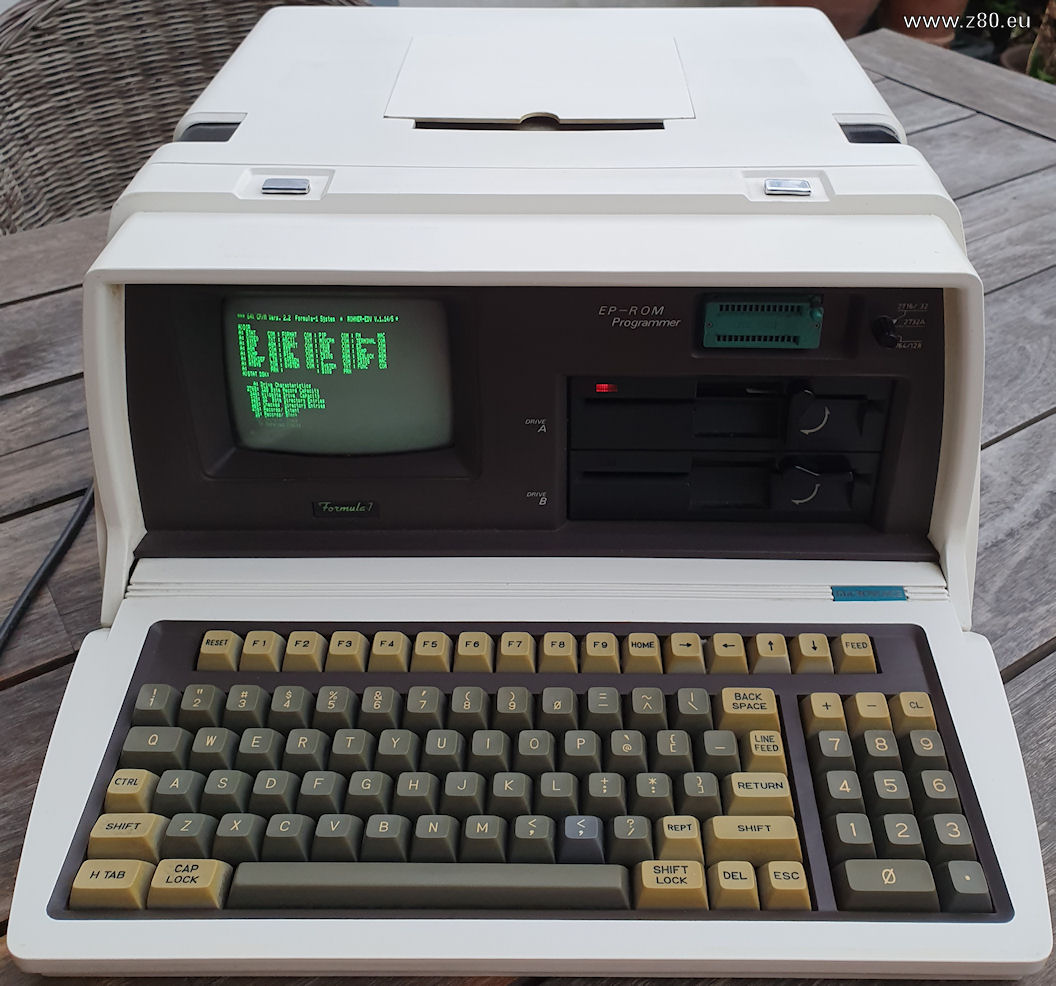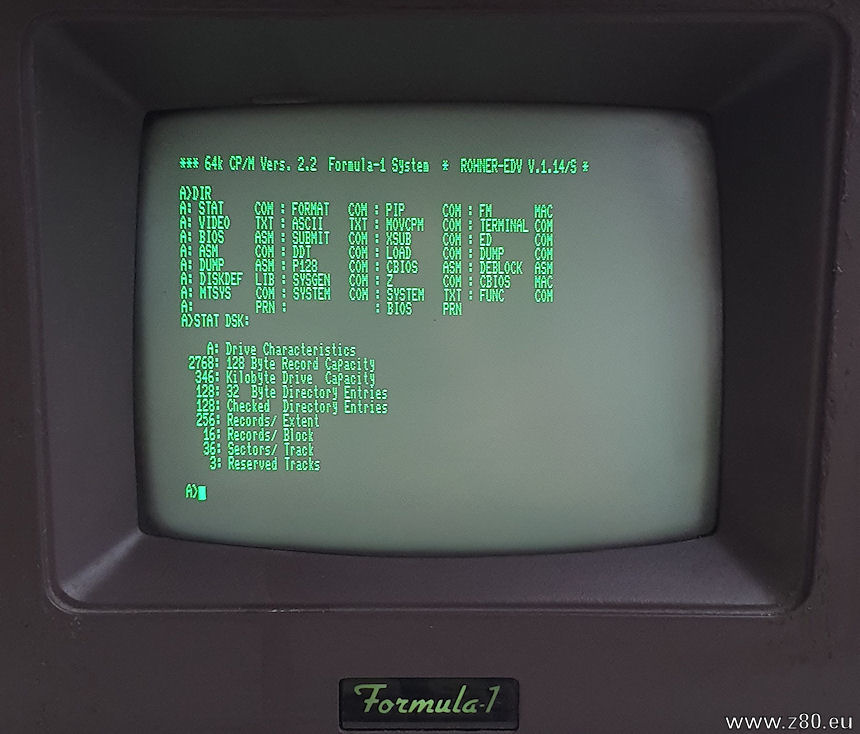This is a *very* nice portable CP/M computer, really rare and perhaps unknown for many, but still worth to be mentioned. It has a Z80 CPU running at 4 MHz, has a build-in eprom programmer (up to 27128) and, like many other CP/M computer, 64KB RAM. It has two 40 track double sided floppy drives (~ 346KB capacity + system tracks), and it has even an external connector for 8 inch floppy drives (the standard IBM format with 77 tracks is used).

Also, it has an integrated thermo paper printer (no chance to get such thermo paper rolls anymore).
Although it’s screen is only 5.5″ sized, it has a really clear and crisp display:

Looks like thermal paper is still fairly common, even if it takes a size not made today you could cur a wider roll down.
Hi!
I have just became the happy onwer of a Yodabashi Formula-1 machine. It looks very, very nice, and it even boots. But it gets stuck at ‚IPL error!“ while accessing the upper floppy drive. I reckon it is looking for its CP/M boot disk. But, I don’t have any boot software. I do have 5.25″ floppy disks and drives to write with, but I don’t have any CP/M software. Is it really necessary to run the CP/M Formula-1 branded version? Or will *any* CP/M 2.2 version do? or, even better, do you have a version available for download?
I will write at http://www.legacyman.nl aboutu it soon, I just received a lot of old stuff. A Kaypro II is also in my collection now, but I haven’t tested it yet. I found a CP/M Kaypro II version at winworldpc.com, will try that.
Many thanks in advance for your response!
Kind regards,
Robbert, the Netherlands.
Hi!
I have just became the happy onwer of a Yodabashi Formula-1 machine. It looks very, very nice, and it even boots. But it gets stuck at ‚IPL error!“ while accessing the upper floppy drive. I reckon it is looking for its CP/M boot disk. But, I don’t have any boot software. I do have 5.25″ floppy disks and drives to write with, but I don’t have any CP/M software. Is it really necessary to run the CP/M Formula-1 branded version? Or will *any* CP/M 2.2 version do? or, even better, do you have a version available for download?
I will write at http://www.legacyman.nl aboutu it soon, I just received a lot of old stuff. A Kaypro II is also in my collection now, but I haven’t tested it yet. I found a CP/M Kaypro II version at winworldpc.com, will try that.
Many thanks in advance for your response!
Kind regards,
Robbert, the Netherlands.
When I was 15 years old, some Japanese friends of my parents invited me to travel to Japan to study Japanese and explore my interest in electronics.
To support myself financially and immerse further in the language, I got a job Arubaito (アルバイト) through this friend who knew the owner of a small computer company called Microvoice Corporation.
I worked there as a student, which is quite common in Japan, for 7 months. I assisted in various tasks, including warehouse operations for order shipments and assembly line work such as adjusting equipment, power supplies, startup testing, printers, making copies of blueprints, and more. Interestingly, when I arrived, the FORMULA 1 computer was already in operation.
After a short while, I was taught how to solder and worked on soldering motherboards for prototypes of a future project called MUGEN.
This new computer was larger, had a bigger GREEN phosphor CRT, and featured a 16-bit CPU, the 8088.
By the way, the logo represents infinity and was crafted by a renowned Japanese calligraphy artist. However, I was tasked with digitizing it using N88-BASIC commands on the NEC PC 8800 computer I had at home. Using line commands, I successfully translated the calligraphy into digital form.
After several testing processes, all the main components (CPU chips, memories, ROM, etc.) were prepared, and along with the motherboards, sent to other companies (like SONY) equipped with robots for large-scale assembly and soldering. Our role shifted to checking and making any necessary minor modifications.
I remember ensuring that each computer worked properly, using the flight simulator for testing. The office was in SHINJU-KU, but the factory where I worked was in Kawasaki, 15 minutes from the MUSASHI KOSUGUI station, near the TAMAKAWA river. From the rooftop of the 3-story building, I could see Cannon’s factory, not far away.
There was only one electronic engineer, who designed the computers, an industrial designer responsible for the casing design, and a computer specialist who programmed the BIOS and ensured that the CP/M and MSDOS operating system software functioned. Except for the computer specialist, the other engineers worked with paper and pencil on drafting tables with built-in rulers and T-squares; I don’t recall seeing any CAD programs at that time in 1984.
Then there was a secretary and some older women working part-time for assembly tasks, parts assembly, etc. In the Tokyo office (where I spent little time), there were commercial staff, English-to-Japanese translators for creating manuals, and the company manager.
I left Japan at the end of 1984, and I didn’t hear anything more about this small company.